Approach: How did the idea come about?
Remote crystalline lakes with abundant wild trout, bordered by beautiful beaches of white ash, furrowed by gigantic vertical walls of granite stone and guarded by immense mountains of centenary coigües, generated in me the desire to explore this untamed destination in the Andes Mountains, Chile.
A few years ago, I discovered through Google Earth four lakes in the great Cordillera de los Andes, and that their difficult peaks define the territorial boundary between two countries, Chile and Argentina. From that moment on, the idea arose of making a self-sufficient longitudinal crossing from north to south, joining these four lakes, a crossing that we would later call "Lo Indómito" (The Untamed), based on the wild nature that penetrates this territory, which makes it practically impossible to advance through its ancestral forests. The mission: "To open a route through the mountain range from Lake Huishue - Los Ríos Region, to the Cardenal Samoré border crossing - Los Lagos Region, crossing and connecting Laguna Gemelas, Lago Gris and Lago Constancia".
 |
| Planned route. Image: Google Earth |
The process:
In November 2021, during nine days with my girlfriend, we did a scouting in packraft through a lost track and difficult access, reaching Huishue Lake, Gemelas and crossing to the eastern sector of Grey Lake, paddling through its virgin and icy waters, exploring one of the most hidden corners of the Los Ríos Region. That outing allowed us to visualise the complexity of the terrain and later was fundamental to plan in detail the equipment, logistics and technical level necessary to tackle the mission.
 |
| Lago Gris, well equipped with two Anfibio Rebel 2K packrafts and two Anfibio Vertex Tour paddles. Photo: Tamara Olmos |
 |
| Lago Gris, scouting year 2021. Photo: Patricio Sanhueza |
To achieve this type of objective, the use of a packraft is essential. What is a packraft, a professional inflatable boat, compact, resistant and light, weighing only two kilos, designed to be used as a multipurpose tool in outdoor multidisciplines.
 |
| Packraft portage at the mouth of Laguna Gemelas, scouting year 2021. Photo: Tamara Olmos |
Two months before the crossing:
This time I invited a good friend of mine to be my partner, and when he saw the map, he quickly accepted and we started with the preparations. First of all, we needed to get permission from our work and thus define a date, in addition to acquiring some missing items of equipment and defining the logistics very well.
The journey began:
After intense days arranging the last details, in the blink of an eye, the date had arrived... we found ourselves on a Saturday at 04:30 in the morning driving towards the city of Futrono, anxious to start the approach.
That same day, with the last rays of light, with our backpacks on our shoulders and our mission engraved in our minds, we started the trekking approach from Lake Huishue to Laguna Gemelas.
 |
| Approach to Laguna Gemelas, view to Torre Huishue. Photo: Patricio Sanhueza |
Bombarded by the waders and very hungry, after 7 hours, we finished the first day and set up camp near a river crossing, ate a couple of bars and slept to the tune of frogs and crickets. We knew that the next day we would have a long way to go and with bad weather forecast.
Early the next morning we continued our approach, crossing a medium-sized river and struggling through a forest of coigües, something that would become routine in our adventure.
That afternoon, going down the portezuelo of the Huishue Tower, in a permanent fight against the quilas, in the distance we could see a turquoise mirror that reflected the immensity of a granite wall, we accelerated our pace and we were already next to it... Laguna Gemelas.
 |
| Portezuelo Torre Huishue, view to Playa sector Norte Laguna Gemelas. Photo: Hans Müller |
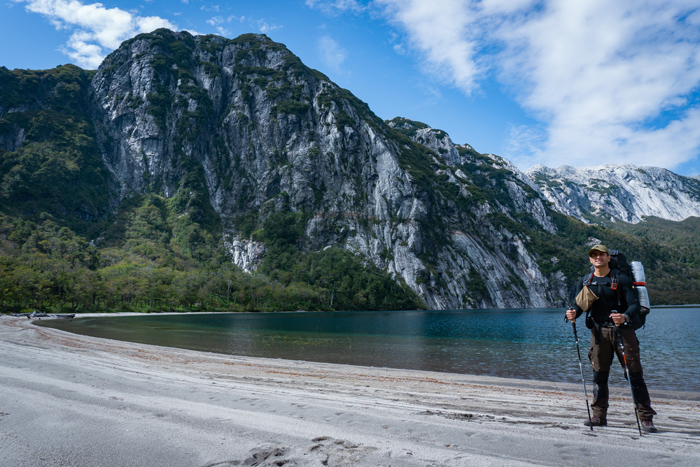 |
| Beach North sector Twin Lagoon. Photo: Patricio Sanhueza |
Finally a replenishing meal, after two days eating bars, three hundred grams of rich rabioles with bolognese sauce were the perfect dish to keep the mood and replenish some energy, meanwhile, the day was still with us and allowed us to fly with drone over the idyllic beaches that make up the lagoon, no doubt the view of the environment made lunch a moment of peace before the storm.
We folded up the poles and armed the paddles, we took to the water! We knew that moving fast was essential, the sky was closing in and the satellite system warned us of 30 knots of north wind, with rain and snow water precipitation.
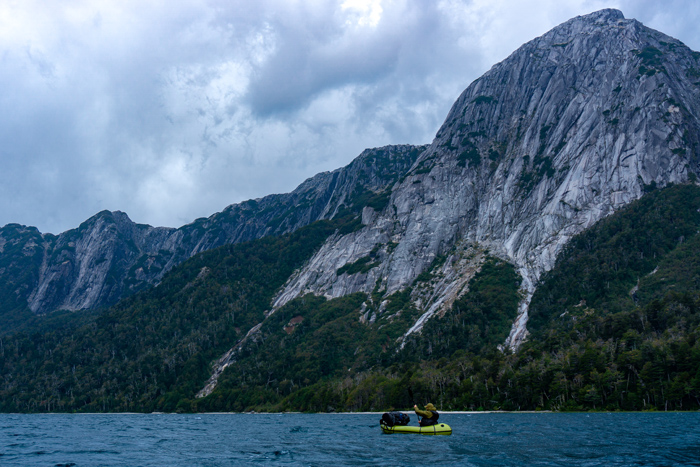 |
| Paddling in the twin lagoons. Photo: Hans Müller |
After a few hours, we were crossing a beautiful river that joins Laguna Gemelas with Lago Gris, it was one of those fairytale rivers, the native forest formed an arch of trees over its waters that hid the rain for a few minutes. Of those 600 metres of river, we had to portage approximately 50 metres, which were not possible to navigate due to large trees fallen over the water.
The rain and wind gave us no respite, to such an extent that we were unable to take out our cameras to take a photographic record on this occasion. Already completely wet, we decided to beach the boats on a dark beach and set up camp, dreaming of eating and having a hot drink.
Once the tent was pitched, a quick swim in the lake was just enough to wash away the fatigue and get back to the temple in clean clothes. The satellite system did not give good news, 48 hours of bad weather was what we had to weather and we had not foreseen it in our planning.
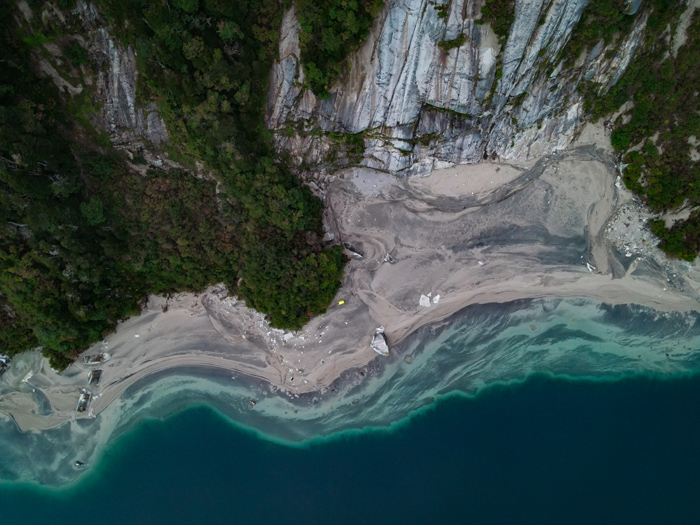 |
| Camp on the beach in the northern sector of Lago Gris. Photo: Hans Müller |
The next day, just under the intensity of the rain, we quickly set up camp and moved to the eastern sector of the lake.
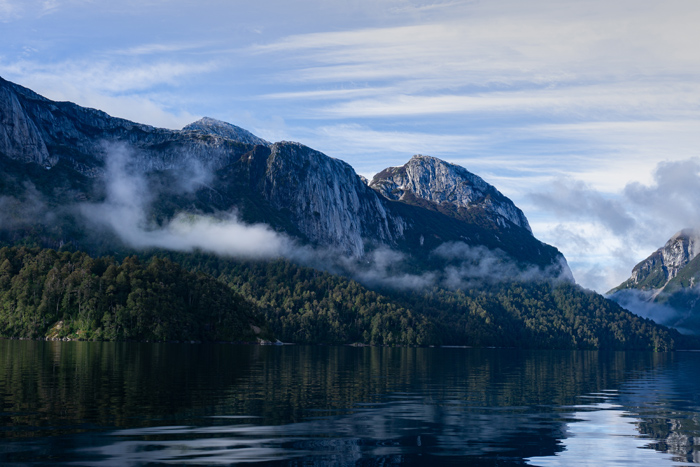 |
| Calm moment at Lago Gris. Photo: Patricio Sanhueza |
During our navigation, the rain again showed us that nature is in charge, letting us see how inhospitable it can be and challenging us to face our mission with conviction. Once again, completely wet, we set up the third camp, the desire to eat a trout was evident, I took out my rod, mounted the lure and made a few casts. While Hans was doing a drone overflight to determine the best route to follow. After a couple of minutes, very close to the shore a big trout took a bite... I carefully removed the hook and let it go... it was too big to feed just two people. After a couple of attempts a medium sized wild rainbow trout put up a good fight and finally fell into the pan and became our dinner while we defined the best route to attack the hill.
The next morning, the mountain took pity on us and gave us a beautiful sunrise, without wind or rain... something we had been waiting for since we started the trip, we took our equipment out in the sun and dried it while we had breakfast.
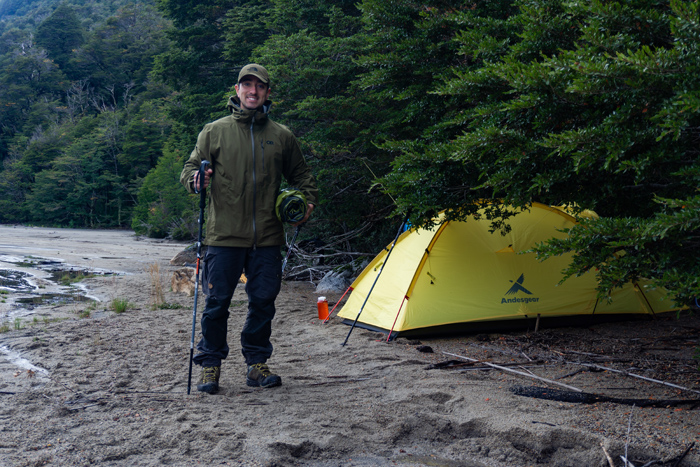 |
| Packed packraft Anfibio Rebel 2K. Photo: Hans Müller |
Again with all the equipment on our shoulders, we went into the forest. After about 30 minutes and in a continuous struggle with the jungle, we decided to go up the mountain by a river, getting wet was our thing, here we go again, into the water!
At one point, as we were descending, I slipped on a steep slope. That day luck was on my side and allowed me to stop before a cliff. From then on, progress was slower and more controlled, one mistake in this place and a rescue team would take a long time to arrive, in case the dense forest allowed satellite connection to call for help.
The next morning, after opening the tent vestibule, we saw that it was snowing and that the great mountains around us were completely covered with snow and clouds... This we had not contemplated, so we decided to keep camp, rationing food.
Very early, with the first light, the weather was benevolent, giving us a nice sun, we packed our backpacks and continued the approach to Lake Constancia.
The progress was much slower than we had imagined, the snow was everywhere and made our footsteps require more energy. On the other hand, the mountain had many undercuts and snowmelt chutes, tiring us heavily as we gained altitude and thus knocking our spirits.
Finally, after many hours of climbing, we managed to find a clearing in the forest with a nice view of the Chile-Argentina border.
 |
| Ascent to the portezuelo of Cerro Campana, Chile-Argentina border. Photo: Hans Müller |
After a short rest, happy to see the portezuelo of Cerro Campana, we decided to hurry up and not waste that window of good weather.
 |
| Portezuelo, east view to Laguna Campana. Photo: Hans Müller |
We noticed that Hans' rucksack had torn and thus lost, in the hostile forest, the tent poles, a trekking pole, a bottle of water, 2 paddle segments and a towel, essential items for our trek.
A month before the trek, we chose very well the equipment to carry, only the essentials, without neglecting our safety. There was no redundancy of equipment, since to be self-sufficient in this type of adventure, it is necessary to use the ultralight policy, a concept that is summarized in "less is more", since packing less weight in the backpack allows us to move more easily in complex terrain, as well as to avoid injuries and fatigue.
Without some of the equipment, we descend to connect with the north beach of the great Lake Constancia.
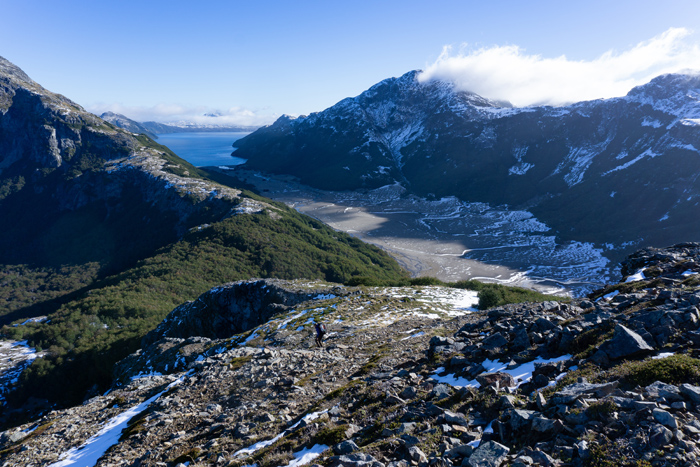 |
| Descent down the south slope of Portezuelo Campana. Photo: Patricio Sanhueza |
We did not want to bivouac, so we did our best to set up and raise the tent, which thanks to its technical characteristics, it was possible to use all its winds to tighten it against the trees and rocks of the sector... one problem less... little by little the smiles and shouts of victory were noticeable, we had finished the most complex part of the track.
The following morning, we explored the west sector of the lake, being amazed by every corner we found, so we decided to change camp to an idyllic beach of turquoise waters that was covered by a soft blanket of snow ... a small paradise in a place that has proved indomitable to our progress.
 |
| Paddling on Lake Constancia. Photo: Patricio Sanhueza |
 |
| Camping on the beach in the Northwest sector, Lake Constancia. Photo: Patricio Samhuaza |
 |
| Navigation in Lake Constancia. Photo: Patricio Samhuaza |
The last day arrived, the sun was shining, melting the last remnants of snow on the beach and we said goodbye to its beautiful and scary places, we packed our equipment, loaded it on the boats and continued with the final stretch.
Once we disembark on the south beach of the lake, we start the final trekking towards the Chile-Argentina border crossing "Cardenal Samore". Suddenly it closed and we had barely 10 metres of visibility, a strong white wind covered our clothes, eyebrows and eyelashes with ice. .... It seemed as if nature did not want to let us go. I took out my camera to record and it went out during all the attempts. The wind chill dropped sharply, so we decided to pick up the pace and at the same time guide ourselves with GPS, we couldn't make bad route decisions, as it would exhaust us unnecessarily in the adverse weather conditions. After a few hours, just at the foot of the Cerro Mirador, the wind disappears completely and the sun, our best friend, shows itself and encourages us to continue with the final stretch.
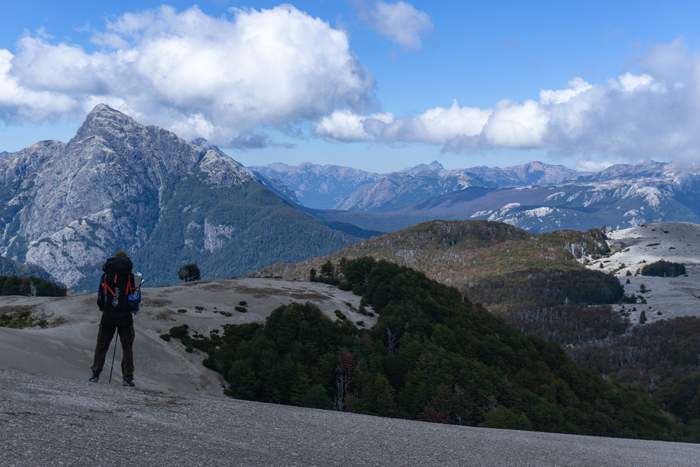 |
| Dunes covered with volcanic ash. East view towards the Argentinian valley. Photo: Patricio Sanhueza |
Suddenly, we heard something different, a constant roar that was slowly approaching us, it was a truck coming down the road from Argentina... We looked at each other, hugged each other with a smile from ear to ear... we did it! We arrived at the end of our journey.
Final comments
This trip has been the most beautiful one I have ever done. We tried to enjoy all those moments that nature gave us, exploring some of the most hidden corners of Caulle and at the same time, feeding our adventurous spirit. It is gratifying to be able to show the untamed landscapes that go deep into the Andes, together with the wild nature that hides behind its remote mountains. Undoubtedly, it was our determination that allowed us to accomplish our mission.
Participants: Hans Müller Manríquez - Patricio Sanhueza Manríquez.
Collaborators: Andesgear - Anfibio Packrafting - Opinel Chile.
Contact: Instagram: patoeduardo.sm / e-mail: patosanhuezamanriquez@gmail.com
Biography: Marine Officer by profession. Lover of wild nature. Fond of exploring pristine places in Chile, using the discipline of packrafting. Starting mountaineering since 2021.
Equipment used:
Packrafts: Anfibio Rebel 2K
Paddles: Anfibio Vertex Tour








